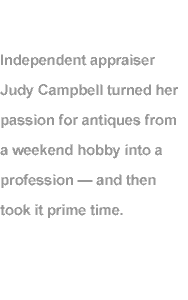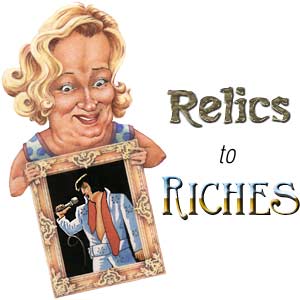 |
|
||||||||||||

|

|
|
By Sarah Smith
|
People often assume that antiques appraisers spend their days surrounded by old-fashioned beauty and delicate objects. Indeed, some days independent appraiser Judy Campbell finds herself unearthing a rare, valuable piece of china from an attic filled with decades worth of a family's odds and ends -- one of the job's perks. But the drawbacks can be everything else in that attic, including dust, grime, and occasional mouse-droppings. Behind every great find are long hours and a great deal of hard -- and sometimes dirty -- work. What Campbell does, at its most basic, is tell people what their stuff is worth. But doing that involves detective work and legal and financial expertise, not to mention a good eye for art. Campbell's clients range from people simply curious about the worth of a single object to families seeking the value of an entire estate for legal proceedings. Campbell, who takes on one appraisal project at a time -- no overlaps -- approaches them all the same way. Once she's determined that she's the appropriate appraiser (she prefers to take projects that fall within her range of expertise, which is in porcelain, silver, and collectibles), she studies the object -- or multitude of them -- and begins an intensive research project. She'll consult books, magazines, the Internet, recent auction results, and other experts in order to unearth the story of a single dish, and therefore be able to determine its monetary value. "It's a learning profession," she says. "It constantly changes as the market changes." An item's value can either be its replacement value (what it would cost to buy at retail) or its fair market value (what it might go for to the right collector). Both fluctuate, particularly the fair market value, so Campbell spends a great deal of time keeping up with trends, prices, and auctions. Recently, Campbell was called upon to assess the value of a sculpture by Marshall Fredericks, an artist who had recently died. When something like that happens, she explains, prices can change overnight. "It was a challenging search, and I made the situation clear in my report to the client, but also indicated what I thought would happen to the price -- that it would go up." She turned out to be right ("Though I'm not always!" she says), a testament both to her skills and her instincts.
To keep up to date, Campbell subscribes to periodicals like Antique Week, peruses auction-house catalogs, and adds to the thousands of books -- ranging from general price guides to art and history texts -- that make up her professional library. "Keeping up with trends is one area where finances have to come out of my pocket," she says. "At a big auction house, I'd have resources all around, but I have to build and constantly add to my library on my own. It's not really something I can expense to a client. I need to know these things." While the big auction houses like Sotheby's and Christie's are often the places where independent appraisers begin their careers, Campbell has had the independence bug since she started her career about ten years ago. After raising two children in Midland, Mich., Campbell decided to turn her amateur interests in the history of decorative arts into a profession. For years, she and her mother had spent long hours antiquing in their native New England -- and many more hours researching the history of their latest find. Professional appraising was a logical step, but moving to New York to pursue a traditional career path alongside the twentysomethings just out of college wasn't an option, with her husband and the rest of her life in Michigan. Instead, Campbell moved to New York for a summer to attend a well-respected, intensive certification program at New York University. There, she took eight courses in subjects like the ethics and practices of the professional appraiser; doing appraisals for IRS and insurance purposes; the history of American, French, and English furniture; and art history. "The series of courses were excellent and taught by leading specialists and professionals in the field," Campbell says. "The intensive study program was equivalent, so we were told, to two and a half semesters of normal course study -- it felt like four years jammed into one brief summer to me. I was brain-dead at the end but so grateful for the wealth of education." She returned to Michigan a certified appraiser. Currently, certification isn't mandatory for personal property appraisers, as there are no federal regulations governing the field. But certification ensures that an appraiser has enough knowledge and training to do his job, and personal property appraisers are lobbying for certification to become mandatory. Campbell believes a law requiring this will be passed this year. Not long Campbell returned to Michigan, the local daily paper called her up to do a story on her new profession -- or what Campbell describes jokingly as a story about "an old lady going back to school." The article led to an assignment to write a trial column on collectibles for the paper -- and Campbell is still fielding "how much is my grandmother's cookie jar worth"-type queries ten years later. Her appraisal business grew up alongside, and supported by, the column. "It's really helped me to gain clients, being visible in the community this way." So has her work with local museums and the annual Michigan Antiques Festival, where she works as the on-site appraiser.
Her visibility was heightened considerably four years ago when she was approached by the then-new PBS TV show, Antiques Roadshow, which was soon to be become a nationwide hit. The show travels from city to city with its expert appraisers, and the public is invited to bring an antique or collectible to a one-day event for a free appraisal. The appraisals of the most interesting items (or the most valuable ones!) are shown on TV. The producers needed an appraiser in her area to check out some large furniture items to see if the pieces were worth having their owners schlep them to the show site. That stint led to her current role as a participating appraiser on the show. She travels to about half the filming sites in the summers, as her schedule (and pocketbook) allow. Campbell, like all the participating appraisers, volunteers her services to the show. "We pay for everything --- travel, food, room, etc.," she explains. "We are not reimbursed for any expenses." But the show is a labor of love, and the benefits come in other forms. Appearing on a highly-rated television show has raised Campbell's profile. She's received calls, letters, and emails from people who've seen her on the show and have questions about their own antiques. "My participation has turned out to be a good form of marketing, although that was not my initial intent," she says. And then there's the great satisfaction of educating the public about antiques. "I'm delighted to participate because [Antiques Roadshow] is continually opening the public's eyes to the wonderful world of antiques and collectibles. It's helping people to become more savvy on those articles that were once believed to be junk or throw-aways," says Campbell. "People are taking a second look at these objects before pitching them in order to learn their historic significance and monetary worth." Not only does she love to share her knowledge of collectibles with the visitors to the show, there's the bonus of being the one to inform them that their often-overlooked heirloom is actually quite valuable. "I love saying to people, 'You might want to think twice about having a garage sale.'" Campbell tends to find only one valuable item out of the 100-125 items she sees at a typical show. Among her oddest finds on Antiques Roadshow was a complete, intact (and appropriately well-preserved) embalmer's bag. The unwitting owner was thrilled at the $2,000 price tag the bag was likely to fetch. Then there was the Little Red Riding Hood string holder, made in the 1940s. "The owner said, 'I don't know what this is, but it sure is ugly, don't you think?'" Campbell recalls. To which, after examining the rather rare collectible, Campbell replied, "Well, if you think something worth $2,500 is ugly -- but I don't think it's so bad." On the flip side, there are dozens of people she has to disappoint. Every now and then someone brings a "valuable" antique that turns out to be a fake. "It's never fun to inform the party of a fake, but when such occasions arise, we identify the piece and explain why we consider it a fake," she says. "They're good learning tools." And then there are the people who find out the treasured heirloom Granny left them may be genuine -- but is definitely not priceless. "I hate telling people their camera is only worth $15. It's terrible to have to say, but people are always so gracious. The show fosters a wonderful atmosphere."
One of the best parts of participating in the show, Campbell thinks, is the opportunity it gives her to interact with the show's other appraisers. Appraising as an IP is mostly a solitary pursuit, due to the hours spent doing research and paperwork. But on Antiques Roadshow, Campbell gets to work with some of the best appraisers in the country. "The expertise of the appraisers I've met and learned from would fill volumes. There's a real camaraderie," says Campbell. "For instance, a nice gentleman brought a bronze Olympic medal to the show. It was awarded to his father in one of the Olympic trials over 70 years ago. How many times does an appraiser run into such a piece? Just about never!" So Campbell consulted a metal specialist, who hadn't ever seen a similar piece, but referred Campbell to another specialist who had. "We were then able to zero in on a precise value and share that information with the owner who was delighted to learn his treasure was worth between $1,000 and $2,000," she says. The days and nights she spends surrounded by objects don't keep Campbell from scouting around on her own behalf. "I'm definitely a collector myself," she says. "There isn't any more wall space left in my house for the plates I collect." But her collections don't stop with fine china. Along with 1950s rock-and-roll memorabilia, Campbell has developed a fondness for old Campbell's soup art. And turning her interest in antiques into a profession hasn't diminished her passion. "I feel lucky that I love what I do," she says. "It's exactly what I want to be doing. I don't plan on retiring." |
||||||||||||||||
|
July 17, 2000 Primary Editor: Katy Demcak Illustrator: Todd Bonita Production: Fletcher Moore |
We'd love to hear your comments about this article! Sarah Smith is Editorial Assistant at Ladies' Home Journal. If you like, we'd be happy to put you in touch with her, or with anyone named in this article. |
||||||||||||||||
|
|
|||||||||||||||||